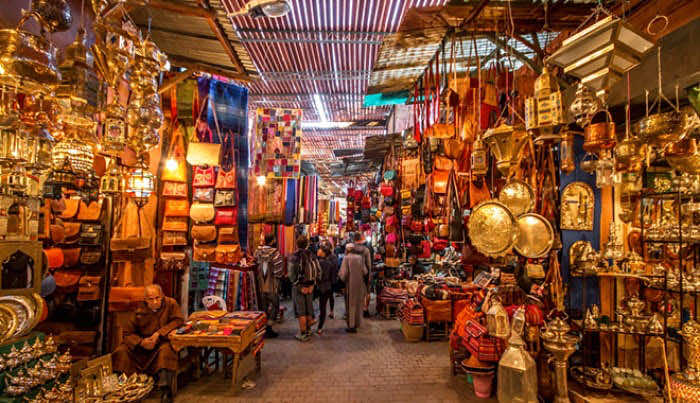1 | Snapshot
Traditional handicrafts (al-ṣināʿa al-taqlīdiyya) remain a pillar of Morocco’s cultural identity and a serious economic actor: the sector generated ≈ MAD 140 billion (≈ US $13.9 bn) in 2024, equal to about 7 % of GDP, and sustained 2.3 million jobs—roughly one in five workers in the active labour force. Barlaman TodayAfricanian
2 | Economic Significance (2024 data)
| Indicator | Value | Comment |
|---|---|---|
| Gross revenue | MAD 140 bn | Production crafts ≈ MAD 96 bn; service crafts ≈ MAD 44 bn Barlaman Today |
| Share of GDP | 7 % | Comparable to mining & quarrying sector Barlaman TodayAfricanian |
| Direct employment | ≈ 2.3 m people | 22 % of working population; 395 000 artisans now in the national registry AfricanianBarlaman Today |
| Export earnings | MAD 1.11 bn | 3 % YoY rise; plant-based crafts alone MAD 101.8 m (9 % of total) Barlaman TodayHespress |
3 | Major Craft Clusters & Flagship Products
| Craft Cluster | Key Cities / Regions | Materials & Techniques | Signature Items | UNESCO / Quality Labels* |
|---|---|---|---|---|
| Zellige & Pottery | Fez, Safi, Meknes | Clay, lead-free glazes, hand-chipped tiles | Mosaic fountains, tagines | Fez blue-white pottery label |
| Leather (Morocco / Maroquinerie) | Fez tanneries, Marrakech | Vegetable-tanned goatskin | Babouches, poufs, journals | Tbourida equestrian show uses same leatherwork (UNESCO 2021) ich.unesco.org |
| Textiles & Carpets | Middle Atlas (Azrou), Taznakht, Chefchaouen | Hand-spun wool, natural dyes, vertical looms | Beni Ourain rugs, kilims | Carpet GI schemes under Maison de l’Artisan |
| Metal Engraving & Jewelry | Tiznit (silver), Fez & Marrakech (brass) | Chisel engraving, filigree, niello | Amazigh fibula (tizerzit), copper trays | “Engraving on metals” listed UNESCO 2023 ich.unesco.org |
| Wood & Thuya Marquetry | Essaouira, Rabat | Thuya burl, cedar inlay, lemon-wood | Cedar boxes, chessboards | Essaouira Thuya label |
| Plant-Based Weaving | Rabat-Salé, Essaouira | Doum palm, alfa grass, reed | Straw baskets (panier), rugs | Fast-growing export niche (+MAD 101 m 2024) Hespress |
*Morocco now grants national “quality labels” (251 artisans certified to date) that function like geographical indications. Hespress
4 | Current Challenges & Policy Responses
| Challenge | Illustrative Impact | What is Being Done |
|---|---|---|
| Global price competition from mass-produced imports | Margin erosion, artisan attrition | Export promotion via Maison de l’Artisan, tariff checks, craft fairs |
| Generational skills gap | Master artisans ageing; fewer apprentices | Tax waivers for maallem mentors, dual-training schools in Fez & Marrakech |
| Fragmented finance & logistics | 90 % of enterprises are micro-units; limited access to credit | New fintech platform with Banque Populaire & M2T for mobile payments and micro-loans (2025 pilot) Walaw |
| Digital visibility | Only ~30 % of units online | E-catalogues, virtual souks, Meta-sponsored Instagram program for craftswomen (2024) |
| Climate risk (water, cedar & thuya over-exploitation) | Raw-material scarcity | Forestry quotas, shift to recycled metals & plant fibres |
5 | Emerging Trends & Innovations (2023-2025)
-
Green Crafts Boom – Plant-based products grew 18 % YoY, powered by EU demand for low-carbon home décor. Hespress
-
Quality-Label Exports – Items bearing the new national label command a 12-15 % price premium in Gulf and US markets. Hespress
-
UNESCO Pipeline – Recent inscriptions (henna rituals 2024; metal engraving 2023) raise visibility and tourist interest in associated workshops. ich.unesco.org
-
Online-to-Offline (O2O) Marketplaces – Start-ups link bespoke web catalogues to Marrakech souk pick-up points, cutting courier costs.
-
Circular-Design Experiments – Fez studios now up-cycle leather off-cuts into phone cases; Essaouira artisans blend reclaimed fishing nets with cedar inlay.
6 | Fresh Research or Business Ideas
| Idea | Value Proposition | Possible Approach |
|---|---|---|
| “Digital Twin” of Historic Souks | VR visitor tours + inventory management for stalls | LiDAR scans + blockchain tags for each craft item |
| Life-Cycle Assessment (LCA) of Zellige vs. Porcelain Tiles | Quantify carbon savings of handmade zellige | Partner with engineering school; ISO 14040 framework |
| Handmade-to-High-Fashion Pipeline | Co-design capsule collections with Moroccan Fashion Week | B2B platform linking maallem cooperatives to designers |
| Craft Apprenticeship Impact Study | Measure income uplift of trainees after 3 years | Randomised control trial with Ministry of Tourism & Handicrafts |
| AI-Enhanced Pattern Archive | Digitise and classify historic carpet motifs for generative design tools | CNN image recognition + Amazigh symbol ontology |
7 | Key Takeaways
-
Culture + Commerce: Moroccan handicrafts are simultaneously heritage preservation and a MAD 140 bn industry supporting millions.
-
Diverse Clusters: From Fez leather vats to Essaouira thuya ateliers, each region specialises in materials deeply rooted in local ecology.
-
Pivot to Quality & Digital: National labels, UNESCO listings and fintech payment rails are the main levers for future competitiveness.
-
Sustainability Is Central: Eco-friendly materials and circular-design pilots are turning traditional know-how into green-economy assets.

ليست هناك تعليقات:
إرسال تعليق